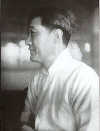|
Xu Beihong: Teacher, Artist, Activist and Patriot
 Xu Beihong, an outstanding Chinese artist and educator of the fine
arts, was born on July 19, 1895 in Yixing, Jiangsu Province. He first learned
art as a child by his father, Xu Dazhang. Xu's works cover a wide range of
styles and mediums, although he is best known for his horse paintings. Xu Beihong, an outstanding Chinese artist and educator of the fine
arts, was born on July 19, 1895 in Yixing, Jiangsu Province. He first learned
art as a child by his father, Xu Dazhang. Xu's works cover a wide range of
styles and mediums, although he is best known for his horse paintings.
Xu joined the work-study program in the French Department at Fudan University
where he taught himself how to sketch in 1916. He went to Japan to study Fine
Arts in 1917 and became a teacher at the Drawing Seminar at Beijing University
upon his return to China. Xu entered the ¨¦cole Nationale Sup¨¦rieure des Beaux
Arts in Paris, France on a government scholarship in 1919 and traveled to a
number of European countries to view and research world-renowned art works. He
returned to China in 1927 and began teaching at the Fine Arts Department of the
Central University in Nanjing and served as the head of the Painting Department
of Nanguo Academy of Fine Arts in Shanghai. Xu was appointed president of the
Fine Arts School at Beijing University in 1928. Xu successively organized a
series of exhibitions by contemporary Chinese artists and his own works since
1933 in France, Belgium, Italy, the United Kingdom, Germany and the former
Soviet Union.
After the anti-Japanese war broke out, Xu held exhibitions in Hong Kong,
Singapore and India, donating all of the proceeds to support the war. After the
founding of the People's Republic of China, Xu was appointed as president of
both the China Artists' Association and the Central Academy of Fine Arts. He
insisted on realism in painting and emphasized a focus on every detail to gain
an overall artistic accomplishment. Xu is anti-conformist in his approach to
painting and very aware of incorporating different styles. As a good sketch
artist, oil painter and Chinese traditional painter, Xu developed his own style
that incorporated strong Chinese characteristics to demonstrate the indomitable
spirit of the Chinese people.
Xu also persistently engaged himself in fine arts education and nurtured a
great number of talents. On October 26, 1953, Xu died in Beijing, contributing
his residence and entire collection of books, calligraphy and paintings to the
country. His works are now on display at the Xu Beihong Museum in
Beijing.
|
|


